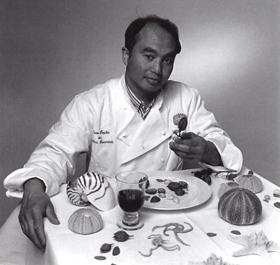An urchin in the storm: food diversity in the Dutch swampscape

Henri Roquas with some of the subjects of his gastronomical-archeological-anthropological experiments
Artist, cook, researcher Henri Roquas has been exploring the relation between humans, food and social histories. In the last 20 years, Henri has looked into the food diversity of the ‘wetlands’ which he explores through a series of experimental dinners. One of the gastronomical projects that Henri has been developing is a concept for a restaurant inspired by the original Dutch swampscape, proving (against historical archeological claims) that the Dutch wetlands are a fertile biotope with an extraordinary culinary potential.
Together with 10 other diners, we had the good fortune of experiencing one of the carefully composed try-out dinners 10th February in Henri’s East Amsterdam apartment titled ‘In de Hollandse Archipel: Nieuwhollands Waterlandkeuken‘ (In the Dutch Archipelago: New Dutch Wetlands kitchen).
A hint of what we forked and devoured includes prawns with pearl barley and marinated turnip and stockfish cream; red beetroot with blackberry syrup salsify and kipper; mackrel with squid, roasted carrots, parsnip and white beans — just a pick of some of the courses.
Through years of kitchen trials and research into the Dutch landscape of food, Henri manages to create an exquisite interplay of textures of seemingly humble fish or roots (turnip, potato, salsify, carrot, beetroot), so-called poorman’s food. The earthy and saline combination is a delicate gastronomic adventure of sea and swamp proteins, carbohydrates and vegetation of the the Dutch Archipelago.
Here is the full menu in Dutch (taken from the invitation):
Een zee-egel in de Storm
Henri Roquas & Partners
Gastronomie, Kunst, Onderzoek Mens & Maaltijd
IN DE HOLLANDSE ARCHIPEL
Menuvoorbeeld
Voorproef
- garnaal, gemarineerde raap, parelgort, stokviscrème
- rode biet, bramenedik, schorseneer, spekbokking
•
Eerste Maal
mosselen, boerenkool, aardpeer, mosterdcrème
•
Tweede Maal
makreel, inktvis, geroosterde wortel en pastinaak, witte bonen
•
Derde Maal
‘Verloren Brood’, perenstroopsaus, ijs van yoghurt met camille,
‘zondvloedwezenkaakje’ (koekje naar recept van de familie
De Zwemmende Hollander – De Vliegende Hollander)
•
Nasmaak
Henri Roquas: Archeologen hebben heel lang gemeend dat het oorspronkelijke Hollandse waterland een wildernis was waar de mens slechts met moeite overleefde. Ecologen hebben er echter op gewezen dat de Hollandse ‘wetlands’, zoals alle ‘wetlands’, tot de vruchtbaarste biotopen van onze planeet behoren. Omdat er zich verschillende ecologische situaties voordoen – droog en nat, zoet en zout, klei en zand – komt er een overvloed aan voedselsoorten voor. Voor de ecologische opportunist de mens is een waterland een waar voedselparadijs. Het is enigszins absurd te denken dat er in Holland geen eigen keuken mogelijk is. Wat is er toch gebeurd waardoor Holland zijn kookkunst verloren heeft, terwijl Vlaanderen, ecologisch en historisch deel van Holland (of omgekeerd), deze heeft weten te behouden?